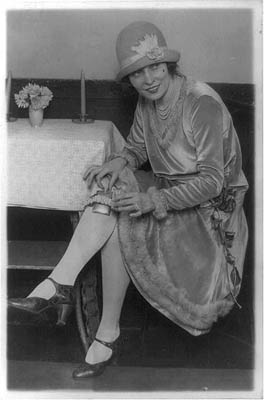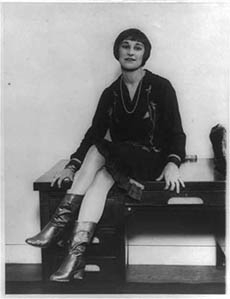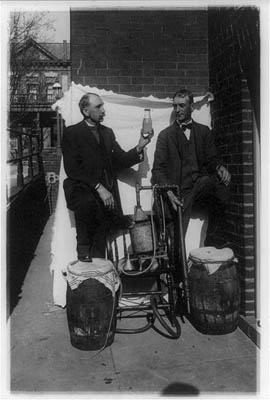 A Vital Part of Ketchikan's History By June Allen September 27, 2002
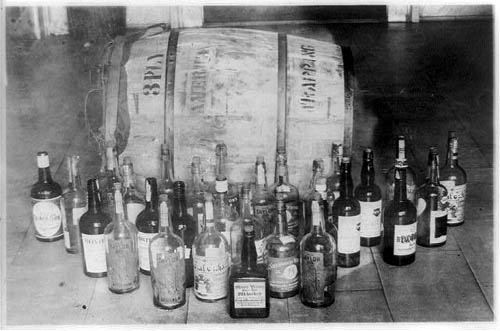 Location Unknown - USA - Photo dated between 1921 and 1932 Courtesy Library of Congress Prints and Photographs Division Washington, D.C. Since tax monies from alcohol
can't be earmarked for specific use in Alaska, the bill may have
more to do with "temperance" than budget balancing.
It appears to be the latest state move in the nation's historical
temperance movement. The national movement is at least 150 years
old and, not surprisingly, it was founded by women. And Alaska's
new HB225 was sponsored by a woman legislator from Anchorage.
HB225's common name was the "10-cent-a-drink" tax hike.
Through compromise, the actual tax increase was more than the
licensed beverage industry would have liked but less than the
temperance sponsor(s) originally had in mind. 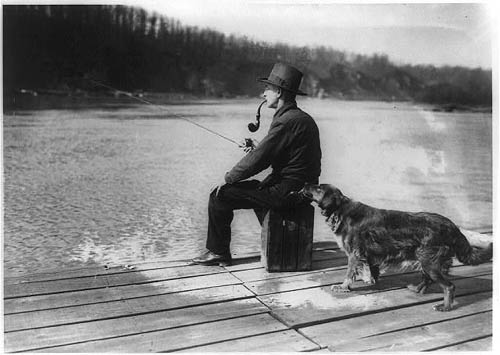 Man seated on pier fishing on the Potomac River, as dog trained to detect liquor takes a bottle from his back pocket. Courtesy Library of Congress Prints and Photographs Division Washington, D.C. The word "temperance" in America was defined originally as "moderation," but segued into "damnation" 150 years ago, and then evolved into out-and-out "prohibition." Since national Prohibition (1920-1933), an experimental disaster, ended, temperance has been practiced via "taxation." The temperance movement in its early years was closely allied with the women's suffrage (right-to-vote) movements begun in earnest in the mid-1800s. While the suffragettes were more peaceable in their marches and lobbying, it was a temperance sister who claimed the first press coverage and nationwide notoriety through the antics of Mrs. Carrie Nation. A six-foot one-inch, 180-pound Mrs. Nation on Dec. 27, 1900, stormed into an elegant bar in Wichita, Kansas, and laid the place waste with a hatchet. She repeated this method of fighting the evils of the Demon Rum during the next decade in 30 more establishments.
The nation's entire history of drinking alcoholic beverages and the resultant temperance movement in the United States is a fascinating story. Temperance began with the Puritans, of all people, drinking beyond the bounds of moderation in the 1700s. It was those largely Puritan New England colonies, which would later become coastal states, that controlled much of the shipping to the Caribbean. It was those same New Englanders who controlled the manufacture of rum, made from molasses from Caribbean cane sugar - one of New England's largest industries at the time. Shrewd Yankee marketing efforts made rum the favorite liquor of all the newly settled part of what would become the United States. It was also their own favorite beverage! Then all through the 1800s there were floods of immigrants crowding the Eastern seaboard cities of the United States of America and spreading into the midwestern hinterlands. There were the Irish - and it was an Irish monk who created the first recipe for whiskey. There were the Scandinavians. Many immigrants came from Germany, some from Eastern European countries brought their recipes for beers with them. Some small efforts eventually grew into large breweries. (Consider the German names Schlitz and Anheuser Busch, for example.) Some of their number opened what they chose to call cafés, serving lunches and beer. This, however, angered earlier English-bred "café" owners. And so the newcomers chose what they considered an elegant word borrowed from the French, "salon," which they pronounced and spelled "saloon." And as populations moved westward and then north, saloon was the name in vogue for beer and spirit establishments when Ketchikan was founded at the end of that busy century.
After the U.S. Purchase in 1867, Alaska was, however, defined as Indian Country. As such, alcoholic beverages were banned in any settlement that had Native Alaskan residents. That law lasted until 1898 but was relaxed because of the unimaginable influx of tens of thousands of gold-fevered prospectors. There was no way the federal government could police Alaska's vast stretches of territory to enforce the ban on alcoholic beverages. So the problem was solved - and the federal government made a little money - by allowing the sale of such drinks in saloons, which were heavily taxed. And saloon owners were happy to pay the tax! Booze had come legally to the last frontier, "booze" being the Americanization of the old English word for heady drinks, "bouse." When Ketchikan became an incorporated city in 1900 it boasted six saloons that brought in a goodly share of the tax monies needed to build a town. By 1903, there were at least eight saloons: the Admiral, owned by John Garrett; the Emerald, owned by Peter F. Gilmore; the Cabinet, owned by Edgar K. Stanley; the Eagle, run by Robert McCoomb (this may have been the bar in the Eagles lodge building); the Ketchikan Club Saloon, proprietor Hans Anderson; the Horseshoe, owned by Joseph E. Lathrop; the Mountaineer, owned by Sam Gowen, and the Sideboard, owned by Mike Martin.
Ketchikan boasted more than one bootlegger! Beer in bottles from Prince Rupert was hauled in burlap sacks which were sometimes dropped in pre-arranged, just-offshore places for pickup at low tide by accomplices. Charcoal Point was another drop-off point. Oldtimers loved to tell the story of accomplices picking up shipments of contraband booze and then being highjacked by others! It was a dog eat dog time in Ketchikan. And everyone knows the stories of the trap doors in the floors of downtown business, which were used to bring up smuggled shipments of booze delivered by skiffs slipping under the streets in the dark of night. The children of Ketchikan benefited, legally, by collecting the empties that floated in on the tides and selling them back to "bottle collectors." Bootlegging was fairly common and, like fish pirates, bootleggers were hard to convict by a jury of their peers. There was one bootlegger story that everyone in Ketchikan at the time remembered, man and boy. There are many versions of the Black Matt story but this is basically the way it goes: Matt Berkovich was said to be from Dalmatia, one of the many regions of Yugoslavia. He came to Ketchikan about 1922, was a fisherman, and discovered the heady profit in bootlegging about 1927, it's said. Twice a week for three years Black Matt made runs between Rupert and Ketchikan and managed to evade trouble. He hired helpers now and then, one of them being a man named Phil Dohm. His nickname happened to be Empty Dohm. The fishermen and bootleggers congregated in shops around the waterfront on Thomas Street and along Stedman. One of those places was The Mint. Stories vary but it was either a barber shop, a pool hall or card room - or maybe it was all of those things. 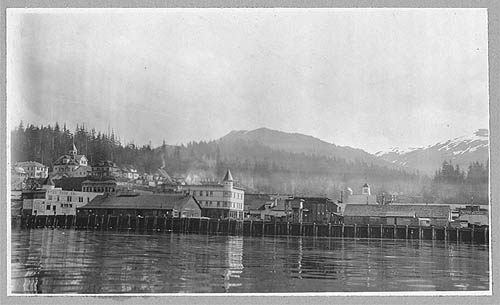 Forms part of: Frank and Frances Carpenter collection (Library of Congress). Gift: Mrs. W. Chapin Huntington; 1951. Historic Photo Courtesy of the Library of Congress Prints and Photographs Division - Washington, D.C. Black Matt finally was busted in 1930 and charged with conspiracy to violate the Prohibition Act. One dark night Black Matt, with the best of intentions and hoping for mercy, broke into the Courthouse (which was up on Grant Street hill then, where the playground is now) and left a bottle or two of good Canadian whiskey on the Judge's desk. The gift didn't work and Black Matt was convicted. While waiting for sentencing, he stormed into the Mint, hoping for consolation from his pals. His former partner Phil "Empty" Dohm was there. He had testified in the case against Black Matt to save his own skin. When Black Matt entered, Phil Dohm picked up an old wooden chair with a backrest that was made of vertical dowels. He held the chairback in front of his face, as if it was prison bars, and began to sing a popular song of the day, "The Prisoner's Song." It goes like this, "Oh, if I had the wings of an angel / O'er these pri-i-son walls I would fly." At the point that Dohm was singing about flying, Black Matt pulled a gun from his pocket and shot the singer dead on the spot. And as the bystanders gasped in shock, he lifted the gun and shot himself in the head. This story has a point: If you live in Ketchikan, a town with a history of such stories and characters, you're one lucky person!
|
||||
